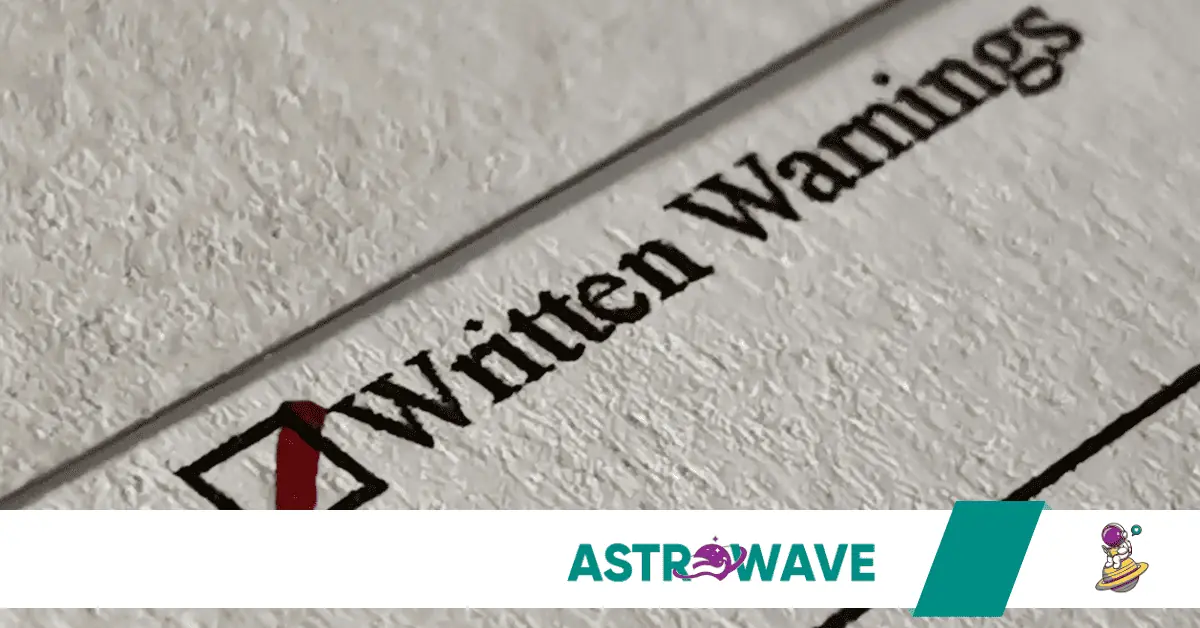The most common challenge we see when an employer wants to terminate is a huge lack of evidence about issues with performance and behaviour in the workplace. The most successful unfair dismissal outcomes,have been because businesses have had all of the documentation in place so their position could successfully be defended.
Introduction
The behaviour we accept becomes the norm…
Performance Management supports businesses to ensure the behaviours being exhibited within the workplace are high quality and therefore has two main purposes for you and your workplace;
- Improve the crew member’s performance; or
- Move them to an exit point from your business (through the provision of warnings and improvement plans)
With that being said, there are some very common myths surrounding Performance Management, Discipline and Termination and we want to boost them into the next galaxy so you don’t need to turn the oxygen up in your helmet when you get stressed about it.
The behaviour we accept becomes the norm. - Astrowave
1. Staff know their job, they don’t need performance reviews or performance management
No matter how well your staff know their job or how well they perform, it is always essential for you to personally keep track of their performance. When they know that their work will be reviewed from time to time, the quality of work increases, and they strive harder to meet your goals.
When staff know their work will be reviewed from time to time, the quality of work increases and they strive harder to meet your goals. - Astrowave

2. Performance Management only takes place once or twice a year
When discussing Performance Management, many people immediately think of the annual performance review process. But the performance appraisal is only one component of what is considered to be performance management.
Performance Management is the continuous process of improving performance by setting individual and crew goals which are aligned to the strategic goals of your business. It is a process of reviewing and assessing the progress of individual staff and crew and providing direction and coaching to maximise the outcomes of each person. For those who aren’t performing it is a vital tool to assess whether they are suited to the role or your business and can be pivotal in exiting them if required.
MOST IMPORTANTLY… It is a continuous process — not a once-a-year activity. Therefore, quality performance management should, bring together a number of different, integrated activities to form an ongoing ‘performance management cycle’.
It is often the responsibility of Human Resources (HR) to present the business case for Performance Management to Senior Management and to explain why it should have a year-round focus. HR are also faced with the need to ensure that line managers are committed to playing their part in such culture change in order to achieve the right business outcomes.
Yet, despite the initial resistance, businesses that adopt the approach of regular and consistent Performance Management processes report not only better performance outcomes and higher productivity, but also staff who are eager to attend performance discussions and are keen to receive feedback.
If you adopt a regular and consistent Performance Management cycle, you could experience higher productivity and staff eager to receive feedback. - Astrowave

3. Verbal warnings do not need to be documented
The term verbal warning refers to “the process of providing direction and/or discipline to staff via a conversation rather than in a written format”.
Verbal warnings like all processes relating to staff should be documented. If there is no record of verbal warnings it is very difficult to prove at a later date that the staff had been counselled about the issue. Managers should always document a verbal warning in some manner, and it is also a good idea to communicate those warnings once documented with Senior Management. Documentation can take the form of a file note in the staff's personnel file, in a shift report or manager’s log or even e-mailing themselves the specifics about the verbal warning (which creates a great time-stamped record that is excellent evidence should there ever be any litigation concerning a termination). Whatever means is used to document the warning, it is important to note:
- The date
- The time
- Any witnesses
- The nature of the issue
- The response from the staff; and
- The agreed resolution to the issue.
Verbal warnings like all processes relating to staff should be documented. - Astrowave

4. Staff have to sign disciplinary documents
Some employers do not think a warning for a staff member is valid unless the staff signs the warning, however this is not strictly true.
While it is a good policy to have some system that proves the staff was presented with the warning, there is no requirement that the staff sign the document. Quite often the staff will refuse to sign such documents because they do not agree with them and are concerned that acknowledging the document by signing it is an admission of guilt. You are then left concerned that the lack of signed documentation leaves you exposed to an argument from the staff about the validity of such documents and whether they ever received it.
To alleviate this, you can include a line on the document that states something to the effect of ‘the staff does not necessarily agree with the warning contained herein, but is signing the document only to acknowledge receipt’. Another method to avoid the argument that the staff never received the written warning is to email the warning documentation to the staff which creates a timestamped record of when the warning was prepared and sent. It is important to note that the warning documentation should be given to the staff in person to ensure they are able to have a discussion about it if they wish, then you can follow up with the email copy to create your paper trail.
It is best practice to provide warning documentation both in person and via email. - Astrowave

5. Termination by text message is an acceptable means of dismissal
Given mobile phones and text messaging are a part of our daily lives, it is not surprising that, from time to time, there is a temptation to avoid “difficult” conversations about a decision to dismiss a staff member by pressing the send button on an SMS.
However, the Fair Work Act 2009 (Cth) requires that a dismissal be communicated in writing in order for it to be effective (s 117(1)).
Yet, the courts have also made it clear that ‘in writing’ includes a text message – so therefore what is the problem?
Dismissal by text message is generally – but not always – indicative of a lacklustre disciplinary process, resulting in the staff member not being afforded procedural fairness or a proper opportunity to defend their employment. The expectation of a fair process can result in dismissal by text message being held to be unreasonable (Pekaj v AAMG Cleaning Group Pty Ltd [2018] FWC 3401).
Dismissal by text message or telephone call will generally only be considered reasonable where it is impractical for the staff member to attend a meeting in person to be notified of the dismissal. This may arise where the decision maker and the staff member are separated by significant distance, or if the staff member has frustrated all other means of their dismissal being communicated.
A good example is Martin v DecoGaze Pty Ltd where the staff was on leave and about to head overseas. In this case the employer had otherwise ensured procedural fairness by allowing a staff member to be heard prior to the decision being made, therefore only communicating the final decision via text message. It is recommended that employers still exercise caution in this regard, and even then, dismissal by text message must be at the end of a process by which the staff member has already had an opportunity to defend their ongoing employment.
Therefore, it isn’t illegal, however as the case law indicates, it should be avoided. Termination via text message really should be a last resort.
Avoiding dismissal by text msg will benefit your business in the long run. - Astrowave

If you are like us and want to have a process in place to ensure you and your staff are aware of how you conduct Performance Management, Discipline & Termination whilst working for your business, or, you want your current process reviewed, connect with us and we can chat about the best way to do this… hint hint it might possibly be in an Astrowave portal!